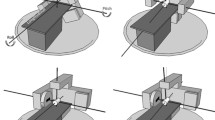Abstract
Purpose
During CyberKnife treatment, the 6D correction method is used to correct patient positional errors, including rotational ones. We developed novel correction methods for translating rotational errors into 3D, with the aim of making their correction safer than with 6D correction and as accurate as possible.
Materials and methods
These novel correction methods were named the gravity correction and the beam correction method. With the gravity correction method, the beam coordinates after rotation are corrected to match the tumor gravity point with 3D translational components translated by the affine transformation matrix. For beam correction, the beam coordinates are corrected to match the translated tumor target coordinates for each treatment beam. The effectiveness and impact of these methods were demonstrated by means of dose volume histogram (DVH) shift evaluation. For analysis of the treatment data of 10 patients, the treatment beam was rotated in three patterns of rotational degree and corrected with the two methods. The amount of tumor gravity point shift in the rotation was also calculated, and the deterioration of the tumor DVH was studied.
Results
In the case of ±1°, ±3°, and ±1° rotation for the X, Y, Z axes, the tumor gravity point of all 10 patients moved around 2.4 mm on average. Tumor DVH was deteriorated worse as the distance between the tumor gravity point and the rotational origin became more distant. With the planned D90, which represents the dose above which 90% of the tumor volume is irradiated set at 100%, the postrotational average D90 dose deteriorated to 96.12% after (±1°, ±3°, and ±1°) rotation. The dose was improved to 99.9% (SD ± 0.41) after the gravity correction, or to 99.87% (SD ± 0.55) after the beam correction.
Conclusion
The correction methods developed by us can correct tumor DVH findings to the same degree as with 6D correction and are safer because the movement required for correcting the linac is not rotational but translational only.
Similar content being viewed by others
References
TR Mackie J Kapatoes K Ruchala W Lu C Wu G Olivera et al. (2003) ArticleTitleImage guidance for precise conformal radiotherapy Int J Radiat Oncol Biol Phys 56 89–105 Occurrence Handle12694827 Occurrence Handle10.1016/S0360-3016(03)00090-7
NJ Yue JP Knisely H Song R Nath (2006) ArticleTitleA method to implement full six-degree target shift corrections for rigid body in image-guided radiotherapy Med Phys 33 21–31 Occurrence Handle16485405 Occurrence Handle10.1118/1.2138009
DC Hornick DW Litzenberg KL Lam JM Balter J Hetrick RK Ten Haken (1998) ArticleTitleA tilt and roll device for automated correction of rotational setup errors Med Phys 25 1739–40 Occurrence Handle9775381 Occurrence Handle10.1118/1.598355 Occurrence Handle1:STN:280:DyaK1cvkvVGjtQ%3D%3D
SA Boswell R Jeraj KJ Ruchala GH Olivera HA Jaradat JA James et al. (2005) ArticleTitleA novel method to correct for pitch and yaw patient setup errors in helical tomotherapy Med Phys 32 1630–9 Occurrence Handle16013722 Occurrence Handle10.1118/1.1914543
DW Litzenberg JM Balter DC Hornick KL Lam RK Ten Haken (1999) ArticleTitleA mathematical model for correcting patient setup errors using a tilt and roll device Med Phys 26 2586–8 Occurrence Handle10619243 Occurrence Handle10.1118/1.598797 Occurrence Handle1:STN:280:DC%2BD3c%2FosValsw%3D%3D
GW Sherouse (1992) ArticleTitleCoordinate transformation as a primary representation of radiotherapy beam geometry Med Phys 19 175–9 Occurrence Handle1620044 Occurrence Handle10.1118/1.596874 Occurrence Handle1:STN:280:By2A3Mfotlc%3D
RL Siddon (1981) ArticleTitleSolution to treatment planning problems using coordinate transformations Med Phys 8 766–74 Occurrence Handle7322074 Occurrence Handle10.1118/1.594853 Occurrence Handle1:STN:280:Bi2C3czlslc%3D
MJ Murphy SD Chang IC Gibbs QT Le J Hai D Kim et al. (2003) ArticleTitlePatterns of patient movement during frameless image-guided radiosurgery Int J Radiat Oncol Biol Phys 55 1400–8 Occurrence Handle12654453 Occurrence Handle10.1016/S0360-3016(02)04597-2
MJ Murphy (1999) ArticleTitleThe importance of computed tomography slice thickness in radiographic patient positioning for radiosurgery Med Phys 26 171–5 Occurrence Handle10076970 Occurrence Handle10.1118/1.598500 Occurrence Handle1:STN:280:DyaK1M7nsVGrug%3D%3D
MJ Murphy (1997) ArticleTitleAn automatic six-degree-of-freedom image registration algorithm for image-guided frameless stereotaxic radiosurgery Med Phys 24 857–66 Occurrence Handle9198019 Occurrence Handle10.1118/1.598005 Occurrence Handle1:STN:280:ByiA2c7nsFw%3D
H Shiomi T Inoue S Nakamura T Inoue (2000) ArticleTitleQuality assurance for an image-guided frameless radiosurgery system using radiochromic film Radiat Med 18 107–13 Occurrence Handle10888043 Occurrence Handle1:STN:280:DC%2BD3M%2FisVeltA%3D%3D
Author information
Authors and Affiliations
Corresponding author
About this article
Cite this article
Suzuki, O., Shiomi, H., Nakamura, S. et al. Novel correction methods as alternatives for the six-dimensional correction in CyberKnife treatment. Radiat Med 25, 31–37 (2007). https://doi.org/10.1007/s11604-006-0092-4
Received:
Accepted:
Published:
Issue Date:
DOI: https://doi.org/10.1007/s11604-006-0092-4




